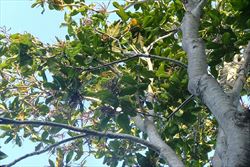Click on images to enlarge

habit of male tree with old flower clusters (Photo: Sheldon Navie)

male tree with old flower clusters (Photo: Sheldon Navie)

base of main trunk (Photo: Sheldon Navie)
Scientific Name
Triplaris surinamensis Cham.
Synonyms
Blochmannia weigeltiana Reichb.Triplaris weigeltiana (Reichb.) Kuntz
Family
Polygonaceae
Common Names
antwood, long Jack, long John, mulato tree, mulato-tree, triplaris
Origin
This species is native to tropical South America (i.e. Brazil, French Guiana, Guyana, Surinam, Venezuela, Colombia, Ecuador and Peru). It is indigineous to the floodplains of the Amazon basin.
Cultivation
This species has been grown as an ornamental tree, and it is occasionally cultivated in suburban gardens in tropical and sub-tropical regions.
Naturalised Distribution
Triplaris (Triplaris surinamensis) trees have been noted naturalising in both the Cairns (i.e. Bramston Beach) and Mossman areas.
Also naturalised and considered to be invasive on Tahiti Island, in French Polynesia.
Habitat
Mulato tree (Triplaris surinamensis) prefers moist areas in lowland situations. It is a potential weed of rainforests, closed forests, waterways, disturbed sites and waste areas in tropical and sub-tropical regions.
Habit
A narrow fast-growing tree usually reaching up to 15-25 m tall, but occasionally growing up to 35 m in height.
Distinguishing Features
- a tall and narrow tree with different male and female flowers on separate plants.
- its large alternatively arranged leaves have yellowish-brown hairs along the underside of the central vein.
- male trees produce large compound clusters of numerous small white flowers.
- female trees produce large compound clusters of reddish-purple flowers.
- the three-winged fruit have hairy bases that contain a single three-sided 'seed'.
Stems and Leaves
The main trunk is straight, and slightly cracked, with greyish or greyish-brown coloured bark. The relatively thick branches and older twigs are hollow, and ants often make nests inside them. Younger branches are slightly ribbed (i.e. striate), greenish-brown in colour and hairless (i.e. glabrous).
The alternately arranged leaves are relatively large and borne on short stalks (i.e. petioles) 10-20 mm long. The leaf blades (10-37 cm long and 4-13 cm wide) are oval (i.e. elliptical) in shape and have a large central vein (i.e. midrib) with numerous (23-32) pairs of prominent side veins (i.e. lateral veins). These leaves also have entire margins and pointed tips (i.e. acute or acuminate apices). Their upper surfaces are hairless (i.e. glabrous), while there undersides have yellowish-brown hairs along the central vein (i.e. midrib).
Flowers and Fruit
Separate male and female (i.e. unisexual) flowers are borne on separate trees (i.e. this species is dioecious). The stalkless or almost stalkless (i.e. sessile or sub-sessile) male (i.e. staminate) flowers are arranged in elongated spikes (6-20 cm long) along with numerous small hairy bracts (about 1.5 mm long). These flower spikes are grouped into larger drooping clusters. Individual flowers have six small white 'petals' (i.e. perianth segments) 5-7 mm long and nine stamens (5-8 mm long). The much more showy, reddish-purple, female (i.e. pistillate) flowers are also borne in compound clusters consisting of several elongated branches (each up to 16 cm long). The individual flowers are borne on short stalks (i.e. pedicels) 2-4 mm long and are also interspersed with small bracts (about 2 mm long). These flowers have six 'petals' (i.e. perianth segments) and three short styles (about 3 mm long). The three outer 'petals' (i.e. perianth segments) become greatly enlarged and they age and enclose the developing 'seed', forming a three-winged fruit.
The three-winged fruit (3-4.5 cm long) are somewhat hairy (i.e. pilose) towards the base and turn from reddish-purple to brown in colour as they mature. The wings (20-35 mm long and 4-8 mm wide) are elongated in shape (i.e. lanceolate or oblanceolate) and have rounded tips (i.e. obtuse apices). Each of these fruit contain a small three-sided 'nut' (i.e. triquetrous achene). These 'nuts' (8-10 mm long and 4-6 mm wide) are brown, shiny in appearance, and topped with three tiny projections (i.e. the remains of the styles).
Reproduction and Dispersal
This species reproduces by seed.
When the fruit are dispersed from the female trees, they fall like numerous small helicopters gyrating towards the ground. They can be carried away by the wind for some kilometres before reaching the ground. The seeds may also be dispersed by water or in dumped garden waste (e.g. lawn clippings).
Environmental Impact
Mulato tree (Triplaris surinamensis) is regarded as an emerging environmental weed in northern Queensland. It was recently listed as a priority environmental weed in at least one Natural Resource Management region.
Legislation
Not declared or considered noxious by any state government authorities.
Similar Species
There are no native species that are particularly similar to mulato tree (Triplaris surinamensis), however it is very difficult to tell apart from ant tree (Triplaris americana). These two species can be distinguished by the following differences:
- mulato tree (Triplaris surinamensis) has male and female inflorescences with hairless or slightly hairy branches (i.e. glabrous or puberulent axes). The relatively large male (i.e. staminate) flowers have petals 5-7 mm long and stamens 5-8 mm long.
- ant tree (Triplaris americana) has male and female inflorescences with very hairy branches (i.e. velutinous axes). The relatively small male (i.e. staminate) flowers have petals 2-3 mm long and stamens 3-4 mm long.

